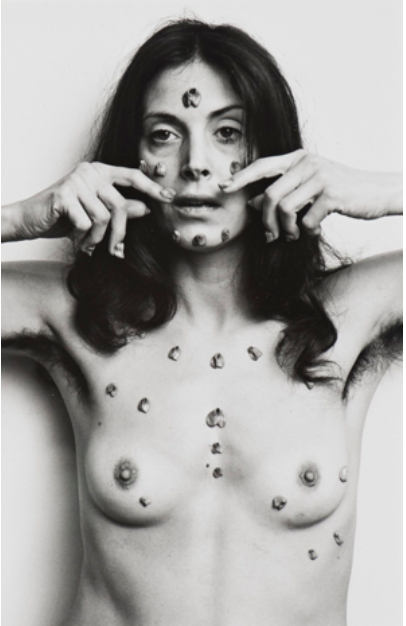CW: nudity
Starification Object Series plays with the ideas of aesthetics, erotism and feminism. The photographs, in black and white, depict the semi-naked body of Wilke adorned with jewels of vulva-shaped pieces of chewing gum. Her captivation with the nude female form reflects the way that second-wave feminism sought to reclaim images of female genitalia as symbols for female empowerment in the 1970s.
The photo series documents her controversial performance art pieces throughout the 1970s and 80s. In these performance acts, she would ask the audience to chew pieces of gum, which she then shaped into vulvae before sticking them onto her semi-naked body. A series of 28 photos were taken to accompany this performance. The gum, which is soft pink, merges into her skin, making it look like parts of her body rather than foreign objects stuck onto her. Thus almost looking like wounds littering her exposed body.

Although Hannah Wilke played around with a number of everyday objects for sculpting, she ended up choosing gum. In her own words, she “chose gum because it’s the perfect metaphor for American women – chew her up, get what you want out of her, throw her out and pop in a new piece”. The disposability of women, a feeling many can likely relate to at some point, is clearly shown in her use of chewed up and spat out gum.

Hannah Wilke’s explicit art is a perfect reflection of the second-wave feminism movement, both in her radical controversy and also in her position of white privilege. The 1970’s feminist movement was radical at the time in the way that they forcefully pushed their concerns into everyday American lives. They were not scared of expressing their femineity, often in ways which American mainstream society felt were too vulgar and explicit. And Hannah Wilke definitely didn’t hold back, she unashamedly expressed her female sexuality while at the same time reclaiming her body from being seen as a sexual object.
The 1970s was a significant decade for female artists working alongside second-wave feminism. Wilke, unsurprisingly faced a great deal of censorship and controversy, leading her to join the Fight Censorship Group. The group fought back against the way that feminist art was treated as erotic and censored. The founder of the group Anita Steckel famously stated that “if the erect penis is not ‘wholesome’ enough to go into museums – it should not be considered ‘wholesome’ enough to go into women”. This group was infamous in the way that they blurred the line between what were considered pornographic images and what could be called an artist expression of the female body.
However, it is important to note that while Hannah Wilke was progressive in the sense of female sexual expression, her existence as a straight white woman within second-wave feminism slotted neatly into the white middle-class dominance of the movement. Although her photos show her topless, with her breasts out, many critics argued that she wasn’t really subverting the patriarchy. It’s undeniable, that she’s a white, slim, beautiful woman, which fits directly into the western patriarchal view of beauty. In some ways, her almost model-like poses, rather seem to uphold this male view of beauty and the male gaze. For others, her photos are seen as pure displays of narcissism.
The prominence of vaginas in Hannah Wilke’s work has also been criticized as essentialist. In some ways, it feels that she is reducing women down to their reproductive organs. This in combination with her statements claiming women were biologically superior due to their childbearing abilities is a point of contention within her work. Reflective of second-wave feminism, her art doesn’t consider the identities and struggles of transgender women.
Her art though is still impactful, especially when seen against the backdrop of Roe v. Wade. A time when women’s rights were being focused intently on whether women should be allowed a choice over their own reproductive health and bodies. Additionally, Hannah Wilke also focused much of her work around the dynamics of being the daughter of Jewish Easter-European immigrants. The title of this piece “starification” is a wordplay on scarification and reflects the branding of Jews with stars during the Holocaust, as well as the physical and mental scars which were inflicted.

While the majority of her works focus around her naked body, it’s her final series of photos Intra-venus which I find her most powerful. Unlike Starification these photos are in colour and document her chemotherapy. Yet similarly to Starification she doesn’t shy away from her naked body, instead she presents her body in all its agony and sickness to the viewer. In these photos, her power comes not from her physical beauty, as with her earlier works, but from the raw vulnerability and pain, she forces onto the viewer.
Images Hannah Wilke, SOS. Starfication Object Series, 1974.
Courtesy of Collection & Archive, Los Angeles and Alison Jacques Gallery, London via https://www.artsy.net

